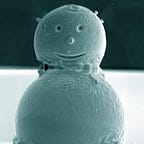Time is real, real numbers are not: Nicolas Gisin
I have been reading “Does Time Really Flow? New Clues Come From a Century-Old Approach to Math” by Natalie Wolchover and the original papers by Nicolas Gisin (1, 2, 3, 4).
Gisin is worth listening to. I think his book “Quantum Chance: Nonlocality, Teleportation and Other Quantum Marvels” (2014) is a masterpiece of clarity and insight. Gisin shows that quantum physics is really nonlocal and nondeterministic.
In the book’s conclusion Gisin says: “As I warned you, you won’t have understood everything. Nobody knows why quantum physics is nonlocal.”
“On the other hand, you will have understood that nature is not deterministic and that it is capable of genuine acts of pure creation. Put another way, it can produce truly chance-like events… these events are irreducibly chance-like and not just something pre-existing that was hidden from us…”
Nondeterministic classical mechanics
In his four recent papers Gisin speculates on classical (non-quantum) mechanics reinterpreted as a nondeterministic theory. The starting point is: Real numbers (infinite strings of random bits) don’t exist in physical reality.
See my book [*] (chapters 18, 19) for the role of real numbers in deterministic classical mechanics and in the challenge to determinism posed by strongly chaotic dynamics.
A real number is an infinite sequence of bits that, for almost all real numbers (that is, for all real numbers but a merely countable, infinitesimally small subset), is a random infinite sequence. Therefore, almost all real numbers can’t be finitely described.
In practice, we never use infinitely precise real numbers, but only rational numbers with finite information. Also, information is physical, and in a finite volume of space there’s no room for infinite information.
In classical mechanics, the evolution in time of a physical system is deterministic only if its initial conditions are infinitely precise real numbers whose infinite bits are given “all at once.” But Gisin proposes to consider physically real numbers as processes that unfold in time.
Of course the question is, how physically real numbers are actualized in time. In “Physics without determinism: Alternative interpretations of classical physics,” Gisin and Flavio Del Santo briefly consider two options. One is that the actualization could happen “spontaneously as time passes.” Another is that the actualization could happen on-demand, just-in-time, when a new physical fact requires it. This opens the door to strong emergence and downward causation [**].
Wolchover explains:
“Recall that we can’t precisely forecast the weather because we don’t know the initial conditions of every atom on Earth to infinite precision. But in Gisin’s indeterministic version of the story, those exact numbers never existed… The digits that specify the weather’s state ever more precisely, and dictate its evolution ever further into the future, are chosen in real time as that future unfolds...”
“In other words, the world is indeterministic; the future is open. Time, Gisin said, ‘is not unfolding like a movie in the cinema. It is really a creative unfolding. The new digits really get created as time passes.’ Gisin said he ‘absolutely’ rejects the notion that information is preserved in nature, largely because ‘there is clearly new information that is created during a measurement process.’”
There are parallels with the intuitionist mathematics pioneered by L.E.J. (“Bertus”) Brouwer. In particular, Gisin’s concept of physically real numbers can be related to Brouwer’s choice sequences.
This seems very preliminary but very interesting, and I’ll avidly follow further developments.
[*] My book “Tales of the Turing Church: Hacking religion, enlightening science, awakening technology” is available for readers to buy on Amazon (Kindle | paperback).
Please buy my book, and/or donate to support other Turing Church projects.
[**] This can be also interpreted as retrocausation: Future events cause past initial conditions to become physically real.
Cover picture from Public Domain Pictures.
